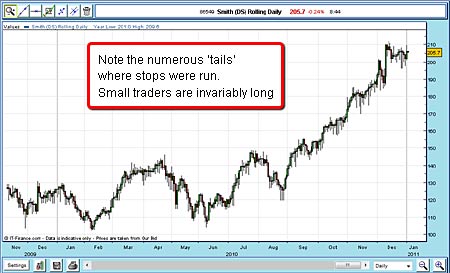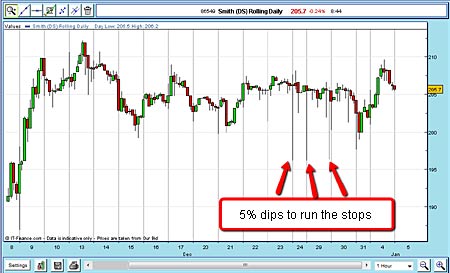Why I don't bet on individual stocks
If you think your spread-betting platform is 'cheating' you by stopping you out for losses, it may be that you're trading in the wrong markets.
Several readers have complained that their spread-betting platform is 'cheating' them and keeps stopping them out for losses.
For them, the annoying thing is that, after being stopped out, the price goes back to where it was and carries on moving upwards.
They believe the platform deliberately goes down to their protective stop, extracting the loss from their account to the benefit of the spread-betting firm - and then resumes its normal path.
MoneyWeek
Subscribe to MoneyWeek today and get your first six magazine issues absolutely FREE

Sign up to Money Morning
Don't miss the latest investment and personal finances news, market analysis, plus money-saving tips with our free twice-daily newsletter
Don't miss the latest investment and personal finances news, market analysis, plus money-saving tips with our free twice-daily newsletter
I am no paid flunky of spread-betting firms, so have no axe to grind here. But I do know that spread-betting firms make their money primarily from the quoted spreads and their hedging activities. Any movements in the quoted prices is a result of genuine buy/sell orders from customers.
These complaints have prompted me to write on why I recommend all traders to trade only the major markets, such as the FTSE, the Dow, the major currency crosses, and so on. These are the markets I cover in my posts.
Of course, most spread-betting platforms offer betting on a whole range of individual shares, and that is where I believe some traders are going wrong.
On my own platform, I am able to bet on hundreds of individual shares - and not just UK companies. I can trade Norwegian shares, Swedish shares, South African shares, and of course, US shares. I am spoilt for choice.
I do know that many traders come to spread-betting from a share-investing background. Often, they own, or have owned, individual shares, and have a kind of emotional attachment to them. So naturally, these are the first vehicles many look to when deciding to spread-bet the markets.
Big mistake!
Why? Unless it is one of the very largest companies in its industry, the daily trading volume is thin, when compared with the huge liquidity in the major markets. Also, as with all company shares, nasty surprises can happen, such as a sudden resignation of the CEO, the sudden loss of a big order, or perhaps the demand of a foreign government for back-taxes.
But that's not all. With trading volume low, wide swings can (and do) happen, especially at the daily market openings, when there can be a big mis-matching of orders that have built up overnight.
Here is an example a UK company called DS Smith plc.
The company is in packaging and office products not the most glamorous industry, but sensitive to the state of the economy. It has sales of £2.1bn, has 10,500 employees and is a leader in the UK in its industry. It is no light-weight. It is listed in the mid-cap FTSE 250 index.
Here is the daily chart:

(click chart for a bigger version)
The feature that stands out to me is the very large number of 'tails' which lie beneath the main body of each daily candlestick.
The market is clearly in a bull phase, but even so, these tails indicate that the market has taken out stops, and then resumed its upward climb. In other words, the share price has fallen to points where lots of investors' stop-losses have been triggered, which then produces a fast-falling market. You can see the results on the candlestick charts, by the long tails pointing down.
Note also that there are very few tails above the main daily trading range. This is clear evidence that most small traders trade from the long side, as we know is true. If most small traders trade from the short side, I could guarantee the tails would appear not below, but above.
Here is a shorter-term chart:

(click chart for a bigger version)
Looking at the trading on 24 December, early trading saw a low of 196, then a rally to 206, where it sat all day. That dip to 196 represented a 5% fall, before trading unchanged. If a trader was placing their stop within 5% of the previous close, they would be stopped out.
My conclusion? If you must trade the small-cap shares, then use wide stops. But I still recommend spread-betting the major markets for these reasons:
Huge liquidity markets cannot easily be manipulated (not true for shares)
24/5 trading very few 'surprises' with trading gaps (no stop slippage)
Respond well to macro economic forces with data openly available
Conform to technical analysis (Elliott waves, Fibonacci retracements)
Huge following in the press (can bet with or against opinion)
Big swing moves that offer big profits
Also, I recommend you use a disciplined approach to money management, such as my 3% rule, and break-even rule.
NB: Don't miss my next bit of trading advice. To receive all my spread betting blog posts by email, as soon as I've written them, just sign up here .
Get the latest financial news, insights and expert analysis from our award-winning MoneyWeek team, to help you understand what really matters when it comes to your finances.
John is is a British-born lapsed PhD physicist, who previously worked for Nasa on the Mars exploration team. He is a former commodity trading advisor with the US Commodities Futures Trading Commission, and worked in a boutique futures house in California in the 1980s.
He was a partner in one of the first futures newsletter advisory services, based in Washington DC, specialising in pork bellies and currencies. John is primarily a chart-reading trader, having cut his trading teeth in the days before PCs.
As well as his work in the financial world, he has launched, run and sold several 'real' businesses producing 'real' products.
-
 Investors will reap long-term rewards from UK equities
Investors will reap long-term rewards from UK equitiesOpinion Nick Train, portfolio manager, Finsbury Growth & Income Trust, highlights three UK equities where he’d put his money
-
 The graphene revolution is progressing slowly but surely
The graphene revolution is progressing slowly but surelyEnthusiasts thought the discovery that graphene, a form of carbon, could be extracted from graphite would change the world. They might've been early, not wrong.